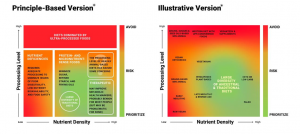
Introducing the Nourishment Table: A New Dietary Framework
Empowers Consumers and Grounding Food Policy in Science
BRUSSELS, BELGIUM, February 4, 2025 /EINPresswire.com/ -- In response to rising health challenges and conflicting dietary advice, a group of leading scientists led by Professor Frederic Leroy of Vrije Universiteit Brussels, has today launched the Nourishment Table - a pioneering framework designed to empower individuals to make informed, personalized food choices while helping to guide developing food policies. Grounded in rigorous evidence and focused on two essential indicators - nutrient density and food processing levels - the Nourishment Table is a flexible, science-driven tool that goes beyond today’s one-size-fits-all dietary guidelines.A Shift from ‘Healthy Diet’ to ‘Adequate Nourishment’:
Conventional advice on “healthy eating” has often fallen short in guiding global populations toward better diets. While consumers in wealthier nations are overwhelmed by food choices, they increasingly rely on ultra-processed foods (UPFs), which are linked to higher risks of health issues such as obesity and metabolic disorders. Despite the prevalence of food choice in high-income areas, the United Nations reports that one in three people globally cannot afford a nutritionally adequate diet, a critical reminder that “healthy diet” guidelines are not achievable for all.
According to recent studies, UPFs, often marketed as health-conscious options, contain high levels of artificial additives, fats and sugars, and, which in combination contribute to overconsumption and adverse health outcomes. Ironically, these foods are sometimes promoted under sustainability or dietary labels, adding to consumer confusion. The Nourishment Table challenges this by promoting a richer concept: “adequate nourishment,” which offers greater flexibility across cultures and economic conditions, while focusing on nutrient quality over mere dietary labels.
The Need for a Common-Sense Framework:
As global entities and governments push the “Great Food Transformation” toward plant-based diets, the Nourishment Table advocates for a balanced approach rooted in individual choice, local cultural values, and economic realities. For many populations, for instance in countries like Pakistan, Egypt, and Mexico, diets low in animal-sourced foods lead to high rates of nutrient deficiencies and appear associated with diseases like Type 2 diabetes, which strengthens the need for dietary guidance that prioritizes health and nutrient density.
“Adequate nourishment is more than just a ‘healthy diet’—it’s a practical, scientifically-backed approach to understanding the foods that meet our physiological needs,” said Frederic Leroy of Vrije Universiteit Brussels, the main author of the Nourishment Table. “We aim to provide a framework that respects individual choice, making it easier for consumers to make nourishing food selections in their daily lives.”
Nourishment Table: Practical, Evidence-Based Guidance:
The Nourishment Table uses two simple but powerful indicators: nutrient density (the ratio of essential nutrients like protein and micronutrients to energy content) and the level of food processing. Evidence supports that diets with a minimum of 25-30% of calories from animal-sourced foods—like meats, dairy, fish and eggs—can support optimal health outcomes. Moderate processing methods, such as fermenting or drying, are also encouraged as they enhance nutrient availability while preserving food appeal and shelf-life.
The Nourishment Table’s recommendations aim to create a “sweet spot” for nutrition, advocating for a core diet based on medium- to high-nutrient-density foods with low or moderate processing levels. This approach is versatile enough to cater to various needs, from traditional diets to specialized populations such as young children, pregnant women, and older adults, and can be adapted for cultural and geographical contexts.
Two Complementary Forms:
The Nourishment Table is presented in two complementary forms: the “principle-based version,” as well as the “illustrative version.”
• Principle-Based Version is a high-level framework which introduces the core principles of nourishment, focusing on the balance between nutrient density and processing. It does not delve into specific dietary patterns, but instead offers a conceptual foundation to explore what constitutes optimal nourishment.
• Illustrative Version: Complementing the principle-based framework, the illustrative version provides real-world examples by highlighting historical and contemporary dietary patterns. These examples, positioned on the table according to their nutrient density and processing levels, provide practical insight without prescribing specific diets. They illustrate how different approaches to food can support or undermine nourishment, helping audiences relate theory to familiar eating habits.
Together, these versions bridge theory and practice. This dual approach both empowers consumers to make informed choices and also enriches policy debates by providing a deeper understanding of what constitutes nourishment across diverse populations.
Empowering Consumers and Informing Policy:
The Nourishment Table is more than a dietary guide: it is a call for action to policymakers to follow grounded, science-backed food policies that align with sustainability goals without sacrificing nutritional quality. By prioritizing nutrient density and food processing levels, the framework empowers consumers worldwide to make better-informed decisions, cutting through the noise of polarized food debates.
For more information on the Nourishment Table, please visit:
www.nourish-yourchoice.org/
Communications Department
Nourish Your Choice
info@nourish-yourchoice.org
Distribution channels: Agriculture, Farming & Forestry Industry, Culture, Society & Lifestyle, Food & Beverage Industry, Healthcare & Pharmaceuticals Industry, Science
Legal Disclaimer:
EIN Presswire provides this news content "as is" without warranty of any kind. We do not accept any responsibility or liability for the accuracy, content, images, videos, licenses, completeness, legality, or reliability of the information contained in this article. If you have any complaints or copyright issues related to this article, kindly contact the author above.
Submit your press release

